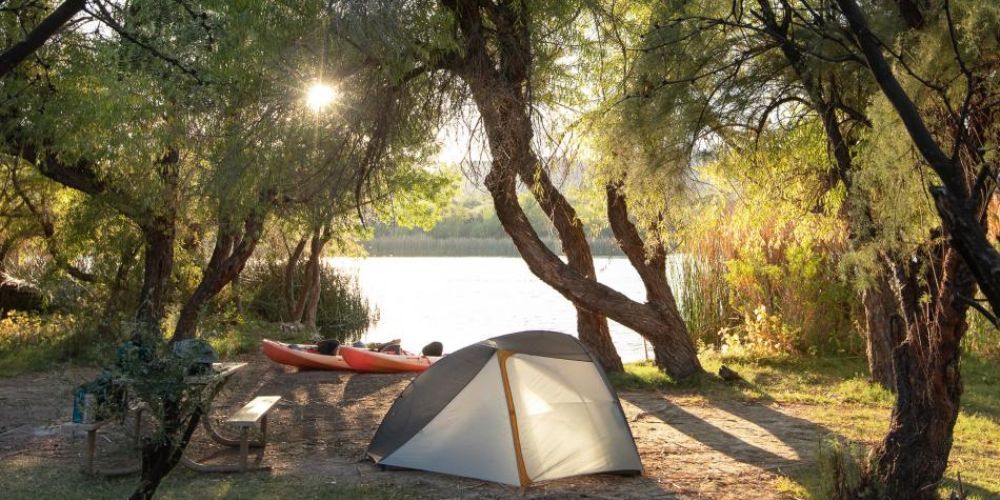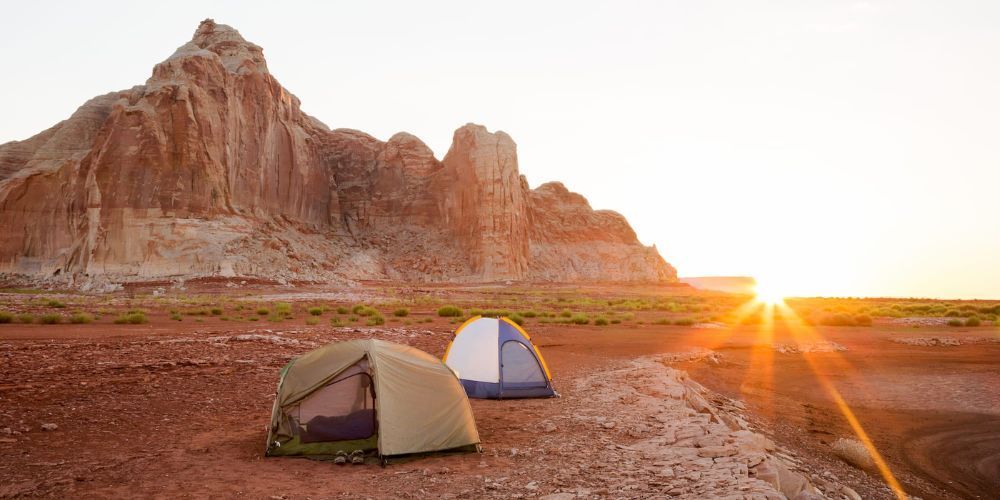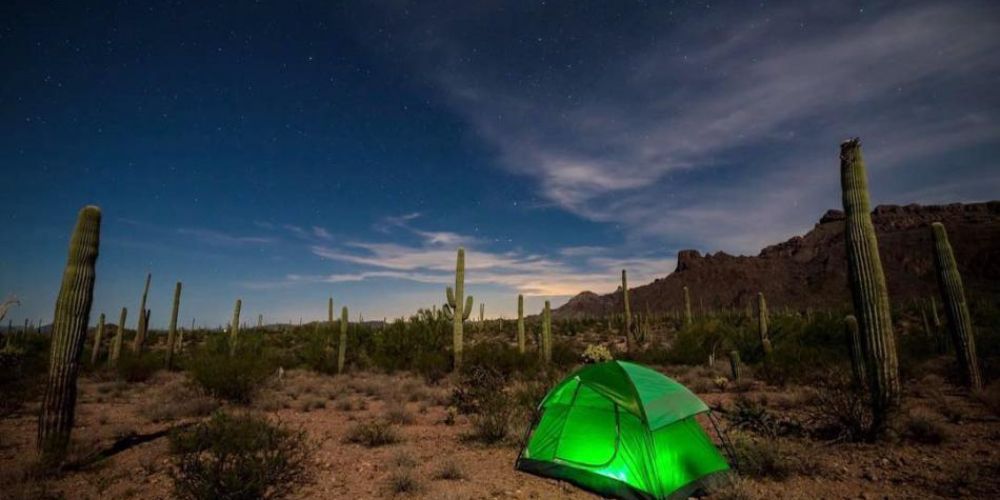Camping in Arizona: Top Activities and Best Camping Spots
Arizona's diverse landscape offers some of the most spectacular camping experiences in the American Southwest. From the pine-covered mountains of the Mogollon Rim to the saguaro-studded Sonoran Desert and red rock canyons, the Grand Canyon State provides year-round opportunities for outdoor enthusiasts to connect with nature in its most dramatic forms.

Hidden Gem Campgrounds in Arizona
While Grand Canyon and Saguaro National Parks draw millions of visitors, Arizona's landscape is dotted with lesser-known camping treasures that offer solitude and stunning scenery.
Lockett Meadow Campground in the Coconino National Forest sits at 8,600 feet in elevation within the caldera of an ancient volcano. This small campground (14 sites) offers stunning views of the San Francisco Peaks and access to some of Arizona's most beautiful aspens, particularly spectacular during fall color changes. The dirt access road is steep and narrow, keeping larger RVs and casual visitors away.
Arivaca Lake Campground south of Tucson offers a remote desert lake experience with just 13 primitive sites. This hidden oasis attracts diverse wildlife and provides excellent bass fishing opportunities while remaining largely unknown to tourists and even many Arizona residents.
White Horse Lake Campground near Williams offers lakeside camping in a ponderosa pine forest, with each site tucked into the trees for privacy. Despite being just an hour from the Grand Canyon, this peaceful lake sees minimal tourist traffic and offers excellent fishing and kayaking.
Fool Hollow Lake Recreation Area near Show Low features lakeside camping in the White Mountains with modern amenities. Despite its convenient location and facilities, it remains less crowded than many other developed campgrounds, offering a peaceful retreat among ponderosa pines.
Grapevine Group Area in Tonto National Forest sits alongside Roosevelt Lake yet remains relatively unknown. Its location at the end of a dirt road deters casual visitors, offering secluded beach access, fishing, and stunning views of the Sierra Ancha Wilderness across the water.
Seasonal Camping Highlights
Spring (March-May): Perhaps Arizona's most magical camping season, with mild temperatures across the state. The Sonoran Desert explodes with wildflowers in March and April, making desert campgrounds like those in Organ Pipe Cactus National Monument and Lost Dutchman State Park particularly spectacular. Spring also brings ideal conditions for exploring the mid-elevation areas like Sedona and the Superstition Mountains before summer heat arrives. Reservations are essential for popular areas during spring break periods.
Summer(June-August): Arizona's climate varies dramatically by elevation during summer. Desert campgrounds regularly exceed 100°F, making them dangerous choices. Instead, summer is the perfect time to explore high-country camping in the White Mountains, Mogollon Rim, and Kaibab Plateau, where elevations above 7,000 feet provide temperatures 20-30 degrees cooler than Phoenix. Afternoon thunderstorms are common in July and August during monsoon season, requiring proper tent placement to avoid runoff channels. High-country lakes offer excellent fishing and relief from the heat.
Fall(September-November): Another prime camping season as temperatures moderate across all elevations. Northern Arizona's high country features spectacular aspen displays in late September and early October, making spots like Lockett Meadow and the North Rim particularly beautiful. By November, desert campgrounds become comfortable again, and fall is an excellent time for stargazing due to clear, dry conditions. Wildlife becomes more active during this season as well.
Winter(December-February): Arizona's diversity shines in winter, with opportunities for both snow camping and mild desert experiences. The Sonoran and lower Mojave desert regions offer pleasant daytime temperatures (60-70°F) and chilly nights (30-40°F), ideal for hiking and exploration. Higher elevations receive significant snowfall, providing opportunities for winter recreation around campgrounds like Catalina State Park (at its base) or Sunrise Park (in the White Mountains). Desert camping during winter holidays is extremely popular, requiring reservations months in advance.
Local Wildlife to Watch For
Arizona's varied ecosystems support diverse wildlife that enhances the camping experience.
Desert Dwellers: The Sonoran Desert hosts America's largest concentration of reptiles. Watch for desert tortoises, Gila monsters (venomous but rarely aggressive), and diverse lizards. While camping, shake out shoes and bedding to avoid unwelcome encounters with scorpions or black widow spiders. The desert comes alive at night—using a red-filtered flashlight helps spot kangaroo rats, kit foxes, and ringtails without disturbing their nocturnal activities.
Mountain Residents: Arizona's higher elevations host elk, mule deer, black bears, and mountain lions. Black bears are particularly active around Mount Graham, the White Mountains, and Mogollon Rim campgrounds. Proper food storage using bear boxes or vehicle trunks is essential. Elk are commonly seen in meadows around sunset and sunrise near northern Arizona campgrounds.
Birds: Arizona ranks among America's top birding destinations with over 550 species. Southeastern Arizona's mountains, known as "sky islands," offer exceptional diversity, particularly near campgrounds like Ramsey Canyon and Cave Creek. Watch for elegant trogons, acorn woodpeckers, and painted redstarts in these areas. Desert campgrounds often feature roadrunners, cactus wrens, and dramatic displays from hummingbirds defending territory.
Reptiles and Safety: While camping, be alert for rattlesnakes (Arizona has 13 species), particularly active during morning and evening hours in warmer months. When encountering a rattlesnake, give it wide berth and allow it to move away. Most bites occur when snakes are inadvertently stepped on or deliberately handled. Simple precautions like using flashlights at night, staying on trails, and checking ground before placing hands dramatically reduce risk.
Best Water-Based Campsites for Swimming, Paddling, and Fishing
In this arid state, water-based campgrounds are especially prized.
Patagonia Lake State Park in southern Arizona offers lakeside camping with excellent swimming beaches, boat rentals, and some of the state's best bass and crappie fishing. The 105 developed campsites include boat-in sites that provide exceptional privacy and direct water access.
Hawley Lake on the White Mountain Apache Reservation features stunning alpine camping at 8,200 feet with rainbow trout fishing and summer water recreation. Permits from the tribe are required, which helps limit crowds. The reflection of ponderosa pines on the clear water creates postcard-worthy camping views.
River Island State Park along the Colorado River near Parker offers beach camping with swimming access. The campground makes an excellent base for paddling adventures on the Parker Strip, a regulated section of river with consistent water flow regardless of season.
Lees Ferry Campground at the start of Grand Canyon sits alongside the Colorado River with 54 developed sites. While not suitable for swimming, it provides access to some of Arizona's finest trout fishing in the clear, cold water released from Glen Canyon Dam just upstream. The campground also serves as a launch point for paddling trips.
Big Lake Recreation Area in the White Mountains offers camping around a 450-acre lake that provides excellent rainbow and cutthroat trout fishing. The five campgrounds surrounding the lake range from primitive to developed, with some sites directly on the shoreline offering easy access for swimming and paddling during summer months.

Camping with a Cultural Twist: Historic or Unique Local Attractions
Enhance your Arizona camping trip by exploring the rich cultural heritage near these campgrounds.
Loy Butte Road Dispersed Camping in the Coconino National Forest provides free camping just minutes from Sedona's red rocks and ancient cliff dwellings. The nearby Palatki Heritage Site features 12th-century Sinagua cliff dwellings and rock art representing several indigenous cultures across thousands of years.
Cochise Stronghold Campground in the Dragoon Mountains offers camping within the natural fortress that Chiricahua Apache leader Cochise used to resist capture in the 1860s. The dramatic boulder formations and cultural significance create a unique camping experience connected to an important chapter of Southwest history.
Catalina State Park near Tucson provides camping beneath the stunning Santa Catalina Mountains with access to ancient Hohokam petroglyphs and grinding holes. Rangers offer guided ethnobotany walks showcasing how indigenous peoples utilized desert plants for food, medicine, and tools.
Twin Arrows Trading Post Camping along historic Route 66 east of Flagstaff offers dispersed camping near the iconic abandoned Twin Arrows Trading Post. This area connects campers with the heyday of America's Mother Road, with several restored trading posts and Route 66 landmarks within easy driving distance.
Bonito Campground near Sunset Crater Volcano National Monument places campers in the midst of an ancient volcanic landscape that dramatically altered Native American settlement patterns in the 11th century. The nearby Wupatki National Monument features multi-room pueblos built following the eruption.

Arizona Campfire Cooking: Regional Dishes and Tips
Elevate your camping meals with these Arizona-inspired outdoor cooking ideas.
Dutch Oven Chiles Rellenos: Roast whole poblanos or Anaheim chiles over your campfire, stuff with cheese and chorizo, then bake in a Dutch oven for a Sonoran-inspired meal. Pre-roasting and peeling peppers before your trip simplifies the campsite preparation.
Navajo Fry Bread Tacos: Make a simple dough from flour, salt, and water, then fry in a cast-iron pan over the fire. Top with seasoned ground beef, beans, cheese, and fresh vegetables for "Indian tacos" inspired by the state's Navajo Nation.
Prickly Pear Margaritas: During summer camping trips, collect ripe prickly pear fruits (using tongs and gloves), then simmer the peeled fruits to create a vibrant syrup. Mix with lime juice and tequila for a distinctly Arizonan campfire cocktail.
Sonoran Hot Dogs: Wrap bacon around hot dogs before grilling over the campfire, then top with pinto beans, onions, tomatoes, jalapeños, mayonnaise, and mustard in a bolillo roll for this Tucson specialty that reflects the region's Mexican influence.
Mesquite Bean Flour Pancakes: If camping in June when mesquite pods ripen, collect and grind dried pods into flour (or purchase pre-made from Native American markets) to add to pancake mix for a sweet, nutritious breakfast with indigenous roots.
Foraging Tips: Desert camping offers unique foraging opportunities including prickly pear fruit, mesquite pods, and piñon nuts in higher elevations. Learn proper identification and always forage ethically with permission where required.
Local Events Near Campgrounds
Time your camping trip to coincide with these unique Arizona events.
Spring
- Tucson Festival of Books (March, Tucson) – Camp at Catalina State Park and attend one of the nation's largest literary festivals featuring hundreds of authors.
- Verde Valley Birding Festival (April, Cottonwood) – Camp at Dead Horse Ranch State Park and participate in guided birding excursions during spring migration.
Summer
- White Mountain Balloon Festival (June, Pinetop-Lakeside) – Camp at Fool Hollow Lake and watch colorful hot air balloons rise above the pines at dawn.
- Prescott Frontier Days & World's Oldest Rodeo (July, Prescott) – Camp at Lynx Lake Recreation Area and experience authentic Western heritage at this historic rodeo.
Fall
- Flagstaff Festival of Science (September, Flagstaff) – Camp at Fort Tuthill County Park and attend free lectures, star parties, and hands-on science activities.
- Tlaquepaque Arts & Crafts Festival (September, Sedona) – Camp at Manzanita Campground and explore this celebration of Southwestern arts set in a replica Mexican village.
Winter
- Tubac Festival of the Arts (February, Tubac) – Camp at Patagonia Lake State Park and browse Arizona's longest-running outdoor art festival.
- Parada del Sol (February, Scottsdale) – Camp at McDowell Mountain Regional Park and enjoy this historic rodeo and Western parade celebrating Arizona's cowboy heritage.
Arizona's diverse camping opportunities offer something for every outdoor enthusiast throughout the year. By exploring these hidden gems and engaging with the state's natural beauty, cultural heritage, and local flavors, campers can experience the authentic Arizona that most tourists miss. From stargazing in the desert to fishing in alpine lakes, the camping experiences in the Grand Canyon State leave lasting impressions that call visitors back season after season.
Author: William Flaiz
Check out these other activities in Arizona
All Rights Reserved | Sports and Nature Gear
